6th and 7th Century Sasanian (Persian) Clothing
The Sasanian Empire existed from the 2nd century (common era) until the
death of the last ruler in 651 ce (Harper 22-23). It covered the geographical
area corresponding to present-day Iran, Iraq, parts of Armenia, Georgia,
Afghanistan, and southern Central Asia (Harper 12).
Images from Sasanian Silverwork
All these references are from "The Royal Hunter: Art of the Sasanian Empire"
by Prudence Oliver Harper.
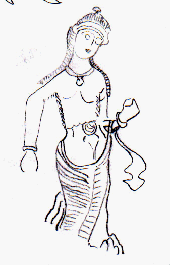 Silver-gilt ewer with female figures (6th or 7th century)
Silver-gilt ewer with female figures (6th or 7th century)
Figure 18
This ewer contains 4 images of dancing female figures. The ladies "are dressed
in long-sleeved, tight-fitting costumes of diaphanous material. Another
piece of drapery encircles the body below the thighs (Harper 61)."
All four figures are wearing "bracelets, anklets, a necklace and a jeweled
diadem (Harper 61)."
According to Prudence Harper's observations, the figures' hair is put up in a
small topknot with several long braids (61).
She brings up the question of what these figures were supposed to represent:
are they remnants of an Asiatic Dionysos cult or are they secular subjects?
She concludes that these figures represent "popular seasonal festivals" in
Sasanian Persia (61).
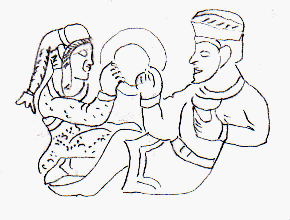 Silver-gilt hemispherical bowl with a ceremonial scene (7th century)
Silver-gilt hemispherical bowl with a ceremonial scene (7th century)
Figure 25 (and detail)
The bowl is decorated with "scenes of court life (Harper 74). The main scene
on the bowl is probably the one of the man and woman sitting on a couch and
holding up a large ring. Prudence Harper reports that this type of figure may
have been associated with a marriage contract (74).
Some of the other scenes on the bowl represent wrestlers, musicians
a game of backgammon, and a feast.
The scene of the woman and man seated on a couch is reproduced in detail
in this book. She is wearing either boots that wrap around the ankle or
sandals with thick straps. Her dress seems to have an area of trim or
other banding under the arm, and also around the neck. Because the part
of her clothes that cover her torso and legs seems to have a different
pattern then the sleeve and shoulder of her garments, I'm going to go
ahead a speculate that she is wearing a long sleeved dress with a piece
of cloth wrapped around her torso. (This would explain the band (or
folded edge) visible under her arm and also the difference in surface
decoration between sleeve and torso).
The woman seems to have one braid or covered ponytail high on the back of her
head. There is what appears to be a band from in front of her ears over
the top of her head, and another one from just above her ears around the
back of her head, right under the base of the braid or pony tail.
The band visible on the back of her head might extend all the way around
and over her forehead as well. There is also a twisted (braided?) rope-like
area across her forehead (it would be on top of the probable forehead band) that
has a tail hanging down in front of the woman's ear. I assume there is another
one on the other side (figure is in profile).
The female musician has the same kind of hairstyle (page 76).
The female musician's garment(s) have the same overall decoration on the torso,
skirt and sleeves/shoulders of the dress. There is a band around the neck.
There is also a banding effect of about a handspan wide around the hem of her
garment. Her dress is ankle length.
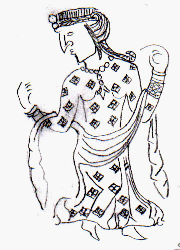 Silver bowl with female musicians (8th century)
Silver bowl with female musicians (8th century)
Figure 26
The figures on this bowl are very stylized, and may not represent the mainstream
of Sasanian art. The women again have long dresses with long sleeves; the
sleeves are closely fitted. Instead of a band around the neck, all the
figures are wearing single strand necklaces of large beads.
The women on this bowl all have areas of banding at the wrist of their gowns,
and they seem to be wearing bracelets as well.
Sasanian textiles and their representation in Sasanian art
The information in this section also comes from The Royal Hunter but
was written by Carol Manson Bier.
Most of the information about the patternings on Sasanian textiles comes from
the rock carvings found at Taq-i-Bostan, between Baghdad and Tehran. The
carvings are very detailed, and it is possible to distinguish cuffs, collars,
hems, closures and even seams (120). Carol Bier indicates that it is also
possible to determine if the surface decoration was intended to represent
a pattern-woven textile, embroidery, applique, or tapestry-woven design (120).
Carol Bier lists three major forms of surface decoration represented in the
rock carvings: repeat patterns of discrete primary motifs (like rows of birds),
repeat patterns of framing elements with primary motifs in the center (like
rows of disks with birds on them), and motifs in a framework (like birds in a
lozenge framework) (122).
Archaeological fragments tell us that the most common method of decoration
was tapestry-weave, and the most common surviving fiber was wool (122).
Surviving textile fragments and literary accounts tell us that red was a very
popular color in Sasanian dress (123).
The heart is a favorite pattern element in the rock carvings. It appears by
itself, in groups to make rosettes and quatrefoils, and as a border element.
Pearls also appear, associated with royal articles of dress (124).
Animals also appear as part of patterned textiles. Birds are the most common,
although boars are also seen. Mythical beasts also appear in patterns (124).
Specific examples of textiles attributed to the Sasanian empire
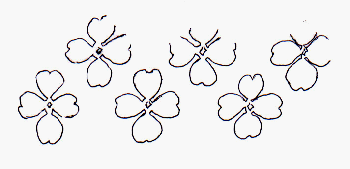 Textile fragment from Syria (early 3rd century)
Textile fragment from Syria (early 3rd century)
Figure 51
Tapestry woven wool in green, three shades of pink, three shades of beige, and
blue. The pattern is a staggered row of quatrefoil rosettes.
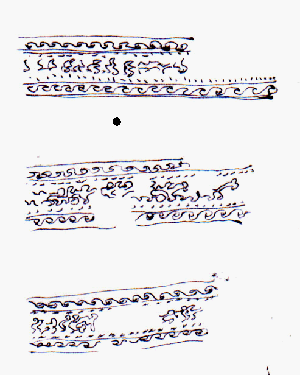 Textile fragment from Syria (early 3rd century)
Textile fragment from Syria (early 3rd century)
Figure 52
Tapestry woven wool in white, two shades of blue, three shades of red. Shaded
stripes with five bands of decorative ornament.
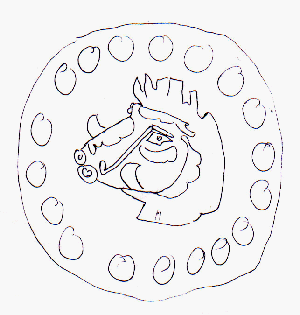 Embroidered textile fragment from Iran (6th or 7th century)
Embroidered textile fragment from Iran (6th or 7th century)
Figure 53
Pearl roundel surrounding a boar's head. Embroidery carried out in wool, using
chain stitch and stem stitch. Blue field with red, white, yellow, tan, and blue
green all outlined in brown.
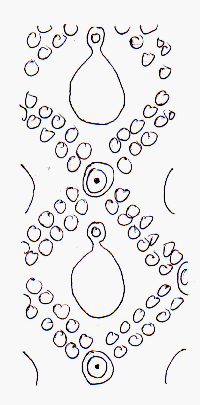 Textile fragment from Iran or Iraq (6th or 7th century)
Textile fragment from Iran or Iraq (6th or 7th century)
Figure 54
A weft faced twill weave in silk. Blue ground with tan, dark orange and white.
The pattern is pendant pearls in a lozenge pattern of double rows of pearls.
Proposed recreation of late Sasanian women's clothing
The figures from these bowls and ewers all have long dresses in common. There
are also drapes or shawls associated with many of the figures.
To make some of
this clothing to wear, I would start with a simple long dress of some fabric
that drapes well, perhaps a fine linen, wool or tightly woven silk. The cut of
the dress would be close fitting through the arms, torso and waist, with a
looser cut to the skirt. It would be easiest to make the skirt fuller by using
gores in the side seams. The neckline of the dress would be round, large enough to
pull over the head and with no other opening. I would include bands of trim or
other decoration at the wrist, and possibly a band of contrasting fabric or
other decoration on the hem of the dress (extending for about 5 or 6 inches).
I would also have a large wrap or shawl to wear. I'd probably make
this about 6 feet long and a yard or so wide.
The hair style is more problematic, but I would start with multiple braids
and a band around my head at forehead level. I might also
put part of my hair up into a top-knot, and braid the remainder into
several braids. I might also add false braids to hang down beside my face.
The addition of a pair of heavy bracelets, a string of large beads, and low
boots or sandals would complete my costume.

This work is licensed under a
Creative Commons Attribution-Share Alike 3.0 License
Last revised May 5th., 2001. Comments to: E. A. Young.
 Silver-gilt ewer with female figures (6th or 7th century)
Silver-gilt ewer with female figures (6th or 7th century) Silver-gilt hemispherical bowl with a ceremonial scene (7th century)
Silver-gilt hemispherical bowl with a ceremonial scene (7th century) Silver bowl with female musicians (8th century)
Silver bowl with female musicians (8th century) Textile fragment from Syria (early 3rd century)
Textile fragment from Syria (early 3rd century) Textile fragment from Syria (early 3rd century)
Textile fragment from Syria (early 3rd century) Embroidered textile fragment from Iran (6th or 7th century)
Embroidered textile fragment from Iran (6th or 7th century) Textile fragment from Iran or Iraq (6th or 7th century)
Textile fragment from Iran or Iraq (6th or 7th century)